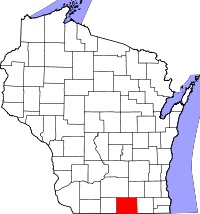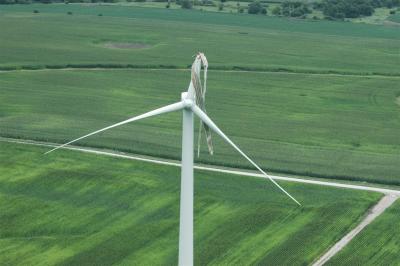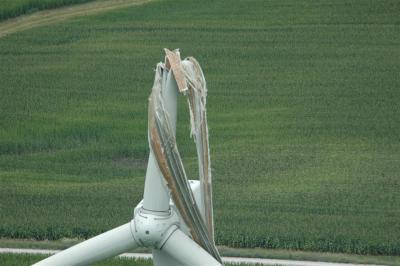 NOTE FROM THE BPWI RESEARCH NERD:How loud is too loud? In the state of Oregon, turbine noise limited to 35 decibels is causing trouble for those who reside in the Invernergy project.
NOTE FROM THE BPWI RESEARCH NERD:How loud is too loud? In the state of Oregon, turbine noise limited to 35 decibels is causing trouble for those who reside in the Invernergy project.
Because of the pulsing characater of wind turbine noise, studies show it to be more disruptive at lower noise levels than noise from road traffic, aircraft, or trains. Chronic sleep disruption due to nighttime turbine noise is the most common complaint from wind project residents Wisconsin.
The new wind siting rules put forth by the Public Service Commission set turbine noise limits in our state at 45 decibels at night and 50 during the day.
The World Health Organization recommends a nighttime noise limit of 40 decibels for healthy sleep. Why the Public Service Commission has chosen noise limits above World Health Organization guidelines is unknown.
WILLOW CREEK TOLD IT MUST QUIET DOWN
SOURCE: East Oregonian,
September 29 2010
By Erin Mills,
A reluctant Morrow County Planning Commission finally spelled it out for Invenergy, the developer of the Willow Creek Wind Project: not only is the project too loud for nearby homes, but Invenergy will be paying for another noise study once its six-month grace period is up.
The 72-megawatt project and four of its neighbors in the Willow Creek Valley north of Ione have been locked in a struggle over noise since before the turbines began turning in late 2008.
After many hours of testimony, the planning commission ruled in May that the project did break the state noise standard, and gave the Chicago-based company six months to comply.
Both parties appealed the decision to the Morrow County Court. The court agreed the planning commission’s decision lacked meat on its bones; it didn’t detail why, or say who was to determine that Willow Creek was in compliance.
At a meeting Tuesday night, commissioners found consensus on several important points. First, they said, the evidence presented by Invenergy’s — and the neighbors’ — noise experts indicated the project broke the state noise rule at nearby homes. The rule states that a wind facility must not increase the ambient background noise of 10 adjusted decibels, or 10 dBA. If a developer does not determine the ambient noise prior to building the facility, there is an assumed ambient of 26 dBA. That means a wind facility that chooses the assumed ambient can generate only 36 dBA at nearby homes.
The commission briefly discussed the percentage of time a facility should be allowed to break the rule, a major point of contention with the two acoustical experts who earlier testified. But Vice-Chair Jeff Wenholz put such quibbling to rest. The developer chose to take the assumed background level, he said, and the noise rule is the noise rule.
“It’s no different than if the speed limit is 65 (mph),” he said. “The cop can write you a ticket for 66.”
The commission next decided that granting Invenergy six months to fix the problem was reasonable, although Pam Docken initially disagreed, saying Willow Creek has already been operating — and breaking the rule — long enough.
“Do you think six months is just flat too long?” asked Chair David Sykes.
“Yes, but I think I’m a solo act here,” Docken replied.
She was right. Eventually she and the group decided Invenergy needs time to adjust. It can finish adjusting sooner than six months, they said, but it must be done when the time is up.
County Counsel Ryan Swinburnson questioned whether Willow Creek should be allowed to run during the six months. The commission agreed it could.
Unlike at previous meetings on the topic, only a handful of people attended, the six neighbors and two Invenergy representatives. Mike Collins, an Invenergy asset manager, said he could not immediately comment on the commission’s decision.
One of the neighbors, Mike Eaton, said he felt numb.
“It’s just a process that we’re in,” he said. “I think the planning commission had a really tough job on their hands.”
Dave Mingo, another neighbor, said Invenergy could fix the problem “in a day,” with an acceptable easement payment. Invenergy made offers to the neighbors shortly after they first complained. All four — two of the neighbors are couples — turned the company down, saying the amount was too small.
The planning commission’s decision vindicated the neighbors’ claims, doggedly expressed for almost two years. But the acknowledged fact — voiced even by commissioners — was that Invenergy would appeal their decision.
“We feel it’s going in the right direction,” Mingo said. “I don’t feel it’s over, by any means.” The planning commission will finalize its decision Oct. 26 at 7 p.m. at Heppner City Hall.
 WIND TURBINES IN THE NEWS
WIND TURBINES IN THE NEWS
Panelists lambaste state about wind power studies
SOURCE: Sun Journal, www.sunjournal.com
September 30 2010
By Eileen M. Adams, Staff Writer,
RUMFORD — Panelists at a wind energy forum Wednesday night lambasted the state for not conducting more studies on the potential impact of wind farms and Dr. Dora Ann Mills, the state’s chief medical officer, for not pursuing possible health issues related to them.
The panelists warned that wind energy would be both more expensive and result in greater pollution.
About 50 people turned out for the decidedly one-sided presentation on potential wind farm development in Rumford and other locations in Western Maine.
The forum, sponsored by the River Valley Wind Education Committee, was held about a month before Rumford and Dixfield voters will decide whether to adopt wind energy ordinances.
Panelist J Dwight, an economist from Wilton and one of the four panelists, said using electricity generated from wind turbines would likely double utility bills by 2020.
“We have enough power already,” he said.
He said later during the forum that First Wind LLC of Boston, Mass., which proposes constructing about a dozen turbines on Black Mountain and an adjacent mountain, is financially bankrupt.
“This is a company that should be scrutinized,” he said.
Dr. Albert Aniel, a local doctor, said Mills has not had a study conducted on the effects of the Mars Hill wind farm on residents there.
“The Department of Health and Human Services is not interested,” he said.
Also speaking was Robert Rand, a sound engineer from Brunswick who displayed a series of graphs showing how sound levels from turbines could affect people living at various distances from a turbine. He also played a recording of two turbines he said was made one mile from the turbines. He was eventually asked to turn off the sound when Rumford wind ordinance committee member Len Greaney asked whether people in the Mountain Valley High School auditorium would have a problem with such noise.
Rand said he has conducted studies or found studies that show how people can become highly annoyed when sounds reach 45 decibels, which is the level sanctioned by the state for nighttime sounds. During the day, the permitted level rises to 55 decibels.
Rumford resident Dan Richard asked whether it was safe to say that the panel is against wind power in general.
“This panel is not in favor of wind,” Dwight said.
Richard said about 600,000 gallons of fuel oil are used each day at the Cousins Island electrical plant.
“And look how many trucks roll in there each day,” he said.
Another man asked whether Rand had measured the level of noise coming from the NewPage mill in Rumford.
Rand said that although he has not measured it, any noise coming from mills tends to be steady, and not variable as he said wind turbines produce.
Karen Pease, a Realtor from Highland Plantation, where another wind farm is proposed, also spoke as part of the panel.
She said turbine construction would decrease the value of homes sited within two miles.
She said a study conducted in Illinois suggested that wind farm developers should guarantee property values, and turbines should be shut down if the noise level goes beyond 10 decibels above ambient sound.
Both Dixfield and Rumford residents will vote on their respective proposed wind turbine ordinances on Nov. 2.

EDITORIAL: "13% ELECTRICITY HIKE TOO MUCH"
Source: globegazette.com
Sept 26, 2010
Hearings began last week on Alliant Energy’s request for a 13 percent electricity rate hike.
We know from past experience the final rate granted by the Iowa Utilities Board will not be 13 percent, but just the same today are urging the board to allow as little a rate increase as possible to cover expenses, as there are many individuals and companies who cannot afford any more.
The increase sought by Interstate Power & Light, a subsidiary of Alliant, would yield $149.9 million to the utility. It said it needs the money to offset additional transmission costs, recover the cost of building the $478 million Whispering Willows East wind farm south of Hampton, recover $3.4 million for past improvements to a generating station in Cedar Rapids, and for environmental controls at its Lansing power plant.
The increase would be on top of a 7 percent rate increase in January, mainly to pay for costs of recovering from record floods in June 2008 and ice storms in recent winters.
The increase sought by Alliant before the 7 percent was granted was 18 percent. So if a similar percentage is granted, customers can expect the current 13 percent increase will result in a 5 percent increase. That’s still pretty hefty for such a short time between increases.
We are pleased, though, with the utility’s investment in wind power in our region. The company has invested $478 million investment in the Whispering Willow-East Wind Farm in Franklin County. According to Alliant, the farm is powering nearly 50,000 Iowa homes with clean, renewable energy.
Green energy is not expensive, Alliant officials have said, nor is installation of pollution control equipment, such as the $188 million investment to reduce emissions from the Lansing power plant.
The consumer advocate office has asked the utilities board to deny the increase and instead order Alliant to reduce electric rates by $1.8 million.
The Mason City Chamber of Commerce has not officially taken a stance on the current rate hike request, but did so last year when the 18 percent request was in play.
Members have expressed concern the current proposal could make Mason City less competitive, said Robin Anderson, executive director of the chamber. She said the chamber helped organize a meeting in June between local members and Alliant officials. From a customer service standpoint, members are satisfied with Alliant, but are concerned their rates will not be competitive in the foreseeable future, she said.
Anderson pointed to a survey of chamber members in 2009. More than 100 members responded. An alarming rate, more than 15 percent, said the rate increases sought at that time would threaten their ability to continue operating in Mason City.
Also, 88 businesses responded to a question about whether utility rates would be considered in a decision to expand in the near future. Sixty-four said they would.
Asked which utility cost impacted their business the most, 69 percent said electricity, 29.9 percent natural gas and one percent water.
Obviously our region’s economic fortunes are closely linked to having competitive, reliable energy. We appreciate Alliant’s reliability and its overall fine standing as a corporate citizen, but ask that it — and mainly the Iowa Utilities Board — go as lightly as possible with this rate increase.
Board Votes not to accept money
SOURCE: TELEGRAM & GAZETTE STAFF, www.telegram.com
September 30, 2010
By Kim Ring
BRIMFIELD — After hearing three hours of mostly opposing comments from residents, selectmen last night voted unanimously not to accept $30,000 from First Wind, the company hoping to build several turbines in town.
The funds would have been used to study the financial impact of a wind energy facility on West Mountain, near Steerage Rock.
About 160 people attended the public hearing at Brimfield Elementary School, most speaking in opposition to the project that would site eight to 10, 400-foot wind turbines on the ridge just north of Route 20, and expressing concern that taking the money would allow First Wind to move closer to its goal.
Board members said if they had decided to accept the money, the town would not have been bound to any future agreements, nor would it have been forced to allow the turbines to be constructed; rather, the money would have helped fund research about the project.
Health Board Chairman Richard Costa and other local officials visited a facility at Mars Hill, Maine, and said he now believes the project would be wrong for Brimfield.
He said residents in Maine told him stories of health issues, decreased property values, and turbine noise difficult to tolerate.
“I don’t really think that this project would be a good fit,” he said, to rousing applause.
Police Chief Charles T. Kuss also went to Maine and said the turbines there, not as tall as the ones planned for Brimfield, were visible from 40 miles away.
He said the folks he spoke with, most of whom favored the project, “did have some economic tie to the industry.”
But some residents of Mars Hill are suing First Wind over the project.
Dr. Elizabeth Smola said she is concerned because recent studies show serious health risks associated with living near wind turbines and being exposed to very low-frequency noise, which is inaudible.
The risks can cause thickening of the heart wall, balance disorders and memory loss, and most often affects fetuses, children and younger people, she said.
In Brimfield, some residents said they favor the turbines and a move toward green energy. One man who lives on St. George Road said he finds the turbines “elegant looking.”
A few residents said that, while they favor green energy, they oppose the turbines in Brimfield, where they would be within 2,000 feet of 79 homes.
“I’m a tree-hugging liberal,” said Anton Prenneis of Brookfield Road, adding that he was initially excited about wind power until he researched what was proposed for Brimfield.
He said as a bluegrass fan who knows the best songs are written about towns devastated by coal mines, “I don’t want to see that happen to the town.”
Dale LaBonte said she drives a Prius, lives in a passive solar home and has no dishwasher, but opposes the wind facility because it will affect the stillness she enjoys while walking her dog at night.
Many were concerned about the “flicker effect” which causes a strobe-like light at certain times of the day. Some, including Doris Carlson, who runs a riding stable on Brookfield Road, were concerned about having to deal with that at their homes.
Eric J. Jaeger, who called himself a “retired reformed opera singer,” said he would, if needed, “sing ‘The Impossible Dream,’ over and over to stop this” project from moving forward.
Clad in a shirt that read “Mafia Go Home,” John Mortarelli vocally opposed the project, saying he’s done research and questioned whether the company is viable and the source of its funds.
He said the town’s bylaws prohibit the towers and that should be enough to quash the project.
But there is concern over Gov. Deval Patrick’s support for a law that would allow the state to have oversight when it comes to siting wind turbines.
Some fear the proposed law would take away local control and make local bylaws that prohibit the towers moot.




